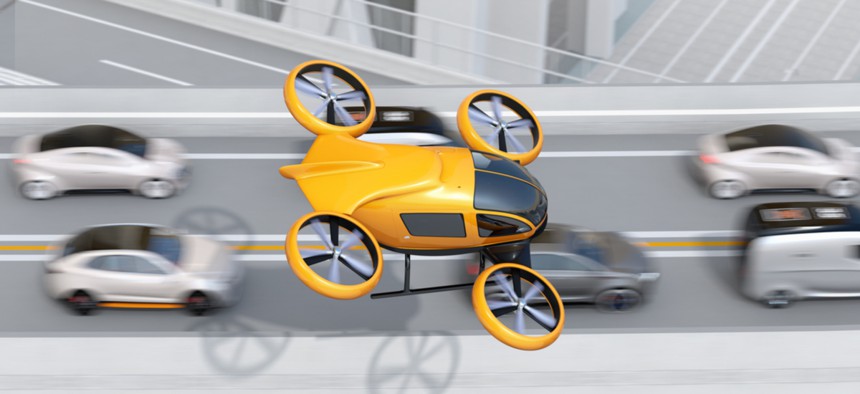Why Flying Cars Are an Impossible Dream

Chesky/Shutterstock.com
The air taxi is the Godot of technology: always on its way, never here.
The flying car is the Godot of technology: always on its way, never here. Ninety years ago, Henry Ford envisioned an experimental one-seat airplane called the sky flivver, only to abandon the project when one of the first prototypes crashed, killing the pilot. In the 1950s, the U.S. Army commissioned the development of “flying jeeps” with private-sector partners like Chrysler. The project never amounted to much. Today, flying cars figure most prominently not in urban skylines, but in venture-capital tag lines,as in Peter Thiel’s motto: “We wanted flying cars; instead, we got 140 characters.” (James Fallows has for many years chronicled the ascendant hopes and stalled realities of air-taxi development around the world.)
Now tech firms again insist that their Godot is finally coming—but, seriously. At the Consumer Electronics Show in Las Vegas in January, the most buzzed-about product was probably Uber’s autonomous air taxi. The ride-hailing company has said that it hopes to roll out an air-travel business by 2023. And last week, Boeing debuted a “personal air vehicle,” an electric-plane prototype.
“Global transit is going 3-D in the next 10 years,” Boeing CEO Dennis Muilenburg said at the World Economic Forum in Davos, Switzerland, last week, on a panel with the chief executives from Uber and UPS. “Advanced propulsion, low-orbit travel, space tourism,” he went on, listing a variety of forthcoming airborne technology: “We know how to do this.” Uber CEO Dara Khosrowshahi agreed that urban transportation is at an inflection point—from cars and trains to drones and planes. “We want to make the city three-dimensional,” Khosrowshahi said, echoing a theme.
But flying cars, air taxis, or to employ the industry term, “vertical takeoff and landing technology,” have their share of doubters. Elon Musk, who typically serves as Big Tech’s mascot of industrial optimism, has said that flying-car dreams have a “fundamental flaw”: They’ll always be too inconvenient for urban commuters to rely on for daily transportation. (Musk has founded at least two transportation companies, but they’re focused on digging urban tunnels and rocketing to Mars.)
Cities aren’t about to let hastily trained pilots commandeer thousand-pound machines and human passengers. The alternative, which is to let autonomous pilots commandeer thousand-pound machines and human passengers, is no more likely. If the world has learned one thing about autonomous technology in the past decade, it’s this: Autonomy is hard. It’s really, really hard. Even self-driving advocates admit that in 2018, the hype around driverless cars came “crashing down.” And speaking of crashing down, the consequences of a self-driving error for an air taxi would be calamitous: a machine the size of a small car hurtling hundreds of feet per second toward a skyscraper, house, or crowded intersection.
“I think the idea of air taxis is kind of bullshit,” Carlo Ratti, an architect and urban theorist who serves as director of the Senseable City Lab at MIT, told me. “Technology can change many things, but it cannot change physics. Helicopters are loud and expensive and, for most forms of transportation, inconvenient.” As near-silent electric and hybrid cars take over the road, the sound of a fleet of flying vehicles buzzing overhead will be even more obvious.
To address this noise problem, companies such as Boeing, Airbus, and Uber are plowing billions of dollars into technologies such as electric propulsion, which could be quieter and more reliable than a combustion engine. But building a fleet of electric-powered aircraft that shuttle passengers hundreds of miles between charges would require heroic advances in battery-energy density.
The chief executives at Davos acknowledged these challenges—and identified others. What kind of city infrastructure would be necessary for autonomous flying machines to take off and land (and charge) within the city? Why would dense, expensive cities like San Francisco approve the construction of dozens of vertical platforms if simply building sufficient apartment buildings is already difficult? How would companies like Boeing achieve the economies of scale required to efficiently manufacture tens of thousands, if not millions, of air taxis without clear signals of consumer demand and city regulatory approval? Good questions.
Several years ago, technologists and transportation companies insisted that self-driving cars would be significant parts of the urban landscape by the early 2020s. That hope is proving illusory. But instead of accepting defeat, the mobility-tech world is shifting its laser beam of optimism from self-driving Earth taxis to self-driving air taxis.
“The last 30 to 40 years in technology have been about digitizing the physical world,” Ratti said. “Experimentation has been easy for tech, because in the digital space, you can test and test infinitely. But the next 30 years will be about building technology that bridges the digital and the physical worlds. It’s a much harder challenge.”
If flying cars have a near-term future, it’s probably not urban. Rural areas—where commutes are long and interruptive skyscrapers are scarce—are the more likely initial setting for airborne technology. Once drones and flying cars prove out in Idaho, perhaps they will migrate to Manhattan. Or not. Flying cars might ultimately be the rare Davos dream that actually makes more sense for a small town like Davos than it does for the major cities its attendees represent.
NEXT STORY: FAA Declares the Super Bowl a 'No Drone Zone'





